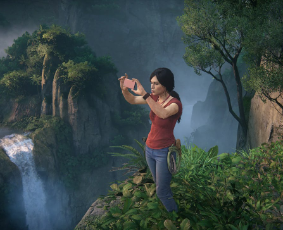This post originally appeared at my secret level just drafts.
I transferred it to this place because my secret level now focuses more strictly on game-based learning, education, and LLM/GPT/AI.
Memory is inseparable from learning, and learning is inseparable from memory. They’re two sides of the same coin, if you think of it. Against this backdrop, what role does personal photography play, i.e., photos that are not created for artistic reasons but to record moments we deem memorable? Certainly, there’s a lot to learn from personal photographs in terms of historical knowledge, but that’s not something we expect from our own personal photographs. We don’t expect to learn from them, we merely expect to be reminded of knowledge we already have, relying on the convenience of a kind of memory refresh machine.
But I suspect there’s more to it, and that we can use personal photography for the learning environment of video games. But beware: these are just wayside thoughts I had while working on a paper; they don’t amount to anything resembling a systematic or scientific inquiry. I’m not even entirely sure which direction Part II of this post is going to take!
In this first part, to pave the ground, I want to highlight some aspects related to in-game photography, and some aspects related to how personal photography is associated with personal memory.
As to in-game photography, the option to make in-game screenshots has been around for a while. A bit more recent, though, is the option to let the player character make photographs with their in-game smartphone, which the player can then keep, collect into albums, and post on social media as if they had made these photographs themself.
In-game photography for “memorable moments” is a clever tool for bringing the player and the player character closer together. This is particularly valuable in games like, e.g., Uncharted 4: A Thief’s End and The Lost Legacy, where the player characters—Nathan Drake and Chloe Frazer, respectively—live their own lives, have their own goals, and make their own choices and decisions, all utterly unaffected by player input. (The difference between choices and decisions is discussed at length in my book Ludotronics.)
Then, there are games that use in-game photography for documenting the state of the world, as, e.g., in Umurangi Generation (a brilliant game that’s still a Steam exclusive, sadly).
Certainly, these two aspects—memorable moments and documentation—are intimately related. And there’s a third aspect involved: individual biography. By recording memorable moments and events, photographs illustrate the story that we tell ourselves about ourselves. (Mind, as John Barth put it in On With the Story, that “The story of our life is not our life, it is our story.”) This story, in turn, does a lot of heavy lifting toward convincing ourselves that we have a coherent past, that we’ve been the person we are right now all along, only more “developed” alongside new knowledge and experiences over time.
But for all these things that photography does for us, it used to come with a trade-off. Photographs don’t merely focus, but narrow down and even constrict our memories to those moments we chose to illustrate. It’s these illustrated moments that we not merely recognize when we see them, but that we are most likely to freely recall, collectively and individually, in the absence of these illustrations—because we also remember the photographs from these events, not just the events. But, precisely because of this, remembering photographs often has the right of way to remembering events themselves. Thus, for moments that we did not choose to illustrate that way, we depend more and more on recognition instead of recall. Instead of remembering them freely, they need to be triggered: through other kinds of “illustrations” like oral or written texts for both collective and individual recognition; and melodies, flavors, and scents for individual recognition. Yet, depending more and more on recognition instead of on free recall, more and more of these unillustrated biographical moments are lost in time.
As a biographical note from my late teens/early twenties, that was one of two reasons why I gave up photography, only a few years after buying a decent camera from money I’d earned during summer break. I’ve always had an excellent memory, but I began to notice that my photographs pulled me toward the memories they illustrated, like irresistible little magnets, and that they made it hard for me to remember events not illustrated by my photographs. (The second reason was that all my photos were crap and didn’t get better, no matter how hard I tried.)
But this trade-off might no longer exist. Sure enough, I picked up making photos again the moment I could do so excessively. Thanks to digital photography, every moment worthwhile can be illustrated now. (Plus, I think I got slightly better at taking photos, but you can judge for yourself.)
These aspects, now, I want to analyze in the context of the original question. What do these aspects imply, and how could they be put to use, with relation to player memory, player/player character bonding, and game-based learning?
Stay tuned for Part II.
If you have something valuable to add or some interesting point to discuss, I’ll be looking forward to meeting you at Mastodon!

